
C H A P T E R 27
Home Festivals
Annual Observances That Uplift the Family & Spiritualize the Household§
 INDUISM IS A CELEBRATORY RELIGION, and nowhere can this be seen more clearly than in the yearly cycle of home festivals. In 1998, renowned Chennai artist S. Rajam sought to immortalize the sights, sounds and foods of the Saivite and Vaishnavite festivals of Tamil Nadu in 12 pieces of art, one falling in each month of the year by the Tamil calendar. A few of these are specific to South India, but most have counterparts in all of Bharat. In each he depicted typical scenes one might encounter during the festival day, as well as the Gods and Goddesses worshiped. The explanations of the art were dictated by the artist himself. At family gatherings, parents, grandparents and relatives can elaborate from their childhood experiences. §
INDUISM IS A CELEBRATORY RELIGION, and nowhere can this be seen more clearly than in the yearly cycle of home festivals. In 1998, renowned Chennai artist S. Rajam sought to immortalize the sights, sounds and foods of the Saivite and Vaishnavite festivals of Tamil Nadu in 12 pieces of art, one falling in each month of the year by the Tamil calendar. A few of these are specific to South India, but most have counterparts in all of Bharat. In each he depicted typical scenes one might encounter during the festival day, as well as the Gods and Goddesses worshiped. The explanations of the art were dictated by the artist himself. At family gatherings, parents, grandparents and relatives can elaborate from their childhood experiences. §

Thai (mid-January/mid-February)§
At left the Sun God, Surya, is being worshiped with the outdoor cooking of a large pot of rice from the recent harvest. The overflowing of the dish is called “pongalo-pongal,” and thus this festival is known as Thai Pongal. Other crops, like sugarcane, bananas and turmeric, are also offered. Kolams (hand-made rice flour patterns) are drawn in the form of the chariot, with the Sun and Moon in the center. On this day cows and other animals are decorated and fed special foods, and their owners prostrate to them. Crows and other birds are offered food on leaves of turmeric. Sisters pray for the welfare of brothers, and elders bless the children. Thai Pongal is celebrated by the poorest farmers and the wealthiest householders.
• • • • • • • • • • • • • • • • • • • • • • •§

Masi (February/March)§
Above, this is the month of Mahasivaratri, Siva’s great night. In the above painting four stories associated with the festival are told. At lower left a hunter has been cornered in a tree-top by wild beasts, where he must spend the night. To avoid sleep, he plucks leaves from the bilva tree, sacred to Lord Siva, and drops them upon a Sivalinga below—a traditional form of worship. Many undertake fasts and stay awake the whole night, praying to Lord Siva both at home and in temples (lower right). The home observance of Karadainombu (upper right) derives from the story of Savitri and her husband, Satyavan. They enter a forest, where he dies. When Lord Yama, the God of Death, comes to take his life, Savitri persuades Yama to let him live. The intent of the observance is that wives not be separated from their husbands. Another explanation of this festival (upper left) is that on this day Lord Siva tied a thread to Parvati’s right hand after their marriage as a sign of protection and fidelity.
• • • • • • • • • • • • • • • • • • • • • • •§
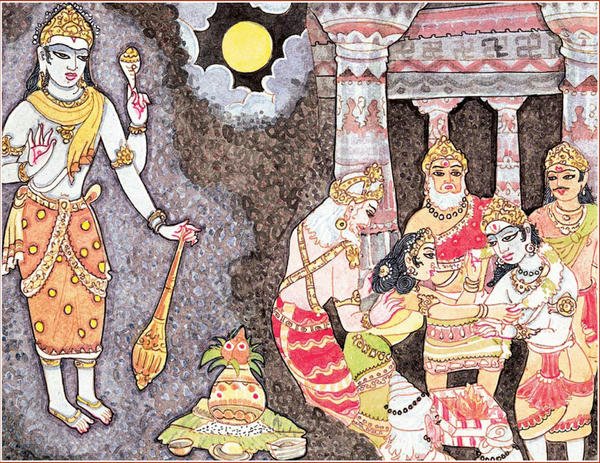
Panguni (March/April)§
This month brings the popular nine-day festival of Ram Navami, celebrating the birthday of Lord Rama, an incarnation of Lord Vishnu. When the full moon rises, Vishnu in the form of Satyanarayana is worshiped before a decorated kumbha pot with a branch of mango leaves placed in its mouth and a coconut on top. Rice is spread on banana leaves and the sacred vessel is completed with a tray of fruits, flowers an betel leaves and nuts. This month is also known for Sita’s marriage to Rama. King Janaka, Dasaratha and priests surround the sacred fire, as Sita garlands Rama in Janaka’s royal palace.
• • • • • • • • • • • • • • • • • • • • • • •§
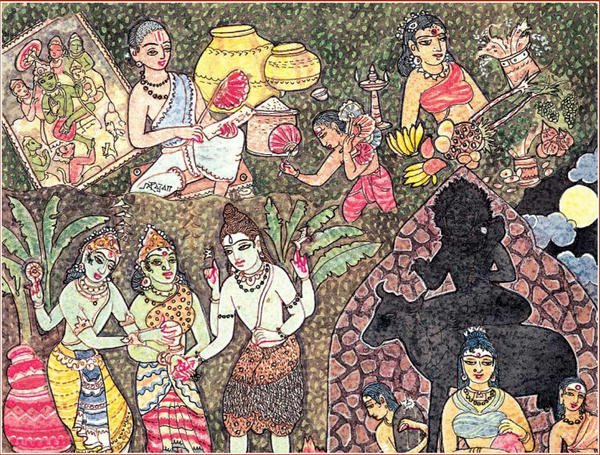
Chitrai (Apirl/May) §
This month (right) begins with he completion of Ram Navami, the nine days of celebration of Lord Rama’s birth ages ago, which started in the previous month. At the upper left we see a decorated picture of Lord Rama’s coronation. Next (proceeding clockwise) comes a Vaisnava priest telling the stories of Lord Rama’s birth and life; behind him are great pots of paanagan, a delicious drink of sugar and ginger, and a basket of sundal, spiced chickpeas, served to the storyteller’s guests, who also receive palm fans, as this is the hot season. Tamil New Year often falls on April 14 (as does the New Year of several other communities). The lady at upper right is shown with the new clothes and jewelry which are part of the celebration, as well as bananas, mangos and the ingredients for vipon pu pachadi, a combination of bitter neem blossoms, sugar and mango—a reminder to face the unpleasant in life with a sweet smile. At lower left is the marriage of Siva and Parvati, Meenakshi Kalyanam, with brother Vishnu pouring the sacred Ganga water on their joined hands. At lower right is the dark form of Yama, Lord of Death, who figures in three stories associated with this month; that of Savitri, who won her husband back from Yama in a battle of wits; Nachiketas, the boy who extracted three boons from Him and Markandeya, who won eternal youth from Lord Yama through the worship of the Sivalinga.
• • • • • • • • • • • • • • • • • • • • • • •§
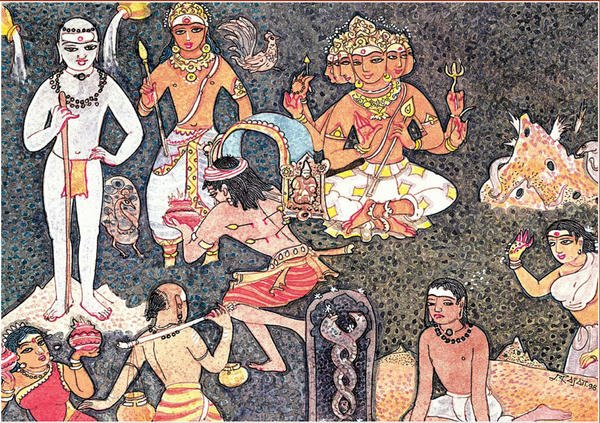
Vaikasi (May/June)§
This month is devoted to the worship of Lord Murugan, who is honored on Vaikasi Visakham (above). He is shown at far left as Palani, the renunciate, dressed in loincloth, wearing a necklace of rudraksha beads, sacred ash covering His body and holding the sannyasin’s staff. To the right He is shown as a prince, with His peacock, and farther to the right as the six-headed Arumugam. Devotees approach Him doing penance by piercing their bodies with small spears and carrying various offerings, including pots of milk and a kavadi, a kind of portable arched shrine. At lower right is depicted Naga Chaturthi, celebrating an ancient story in which a young boy bit by a cobra was saved from death when his sister’s prayers caused the sands of the cobra’s anthill to counteract the poison.
• • • • • • • • • • • • • • • • • • • • • • •§
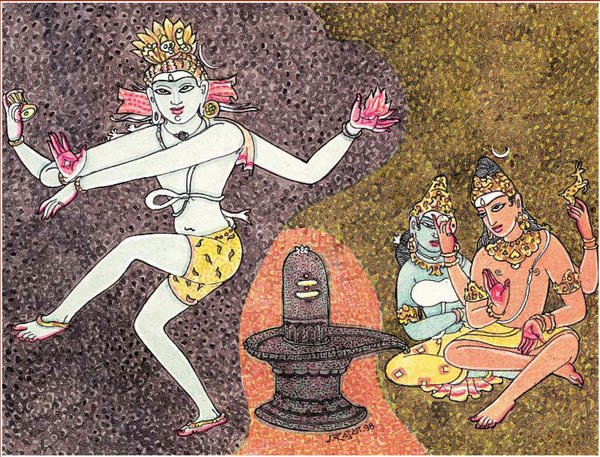
Ani (June/July)§
This is the one month of the year when there are no home festivals—coinciding not uncoincidentally with an intense month of agricultural effort. However, during Ani, major temple festivals are held for Lord Siva as Nataraja, King of Dance (above left), and for Siva and Parvati.
• • • • • • • • • • • • • • • • • • • • • • •§
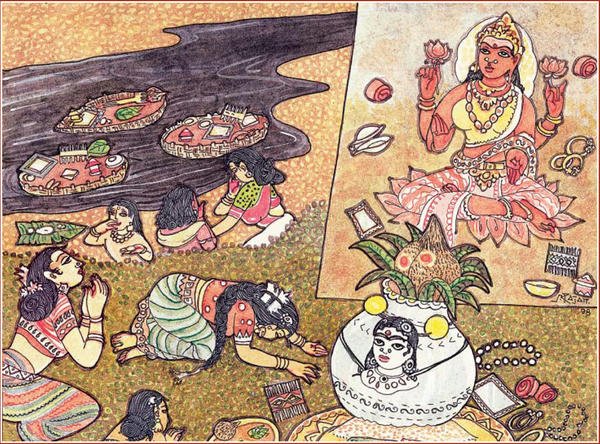
Adi (July/August) §
There are two major home festivals this month. The first is Adi-Perukku, in honor of the Kaveri River. Women and girls go to the nearest river where they place offerings on a bamboo tray (upper left) into the water, then have a feast upon the riverbank. Varalakshmi Vratam (“vow to bring Lakshmi”) is also a ladies’ festival, in which paintings of the Goddess of Wealth are made upon the walls (upper right), kumbha pots intended for worship are decorated with Her image. Beside the pot are placed various cosmetics, comb, beads, etc., and worship is done. Then the ladies sing songs inviting the Goddess to their home. Kozhukkatai, rice and jaggary cakes, are a favorite of the day. In the evening, friends are invited to the home and given clothing, coconuts and sweets.
• • • • • • • • • • • • • • • • • • • • • • •§
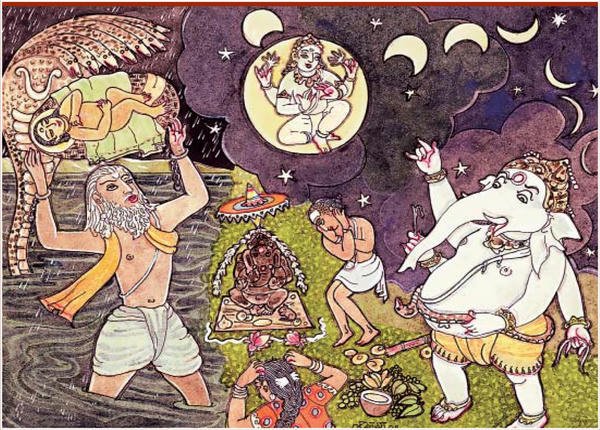
Avani (August/September)§
This is a busy month, with two major festivals celebrated both at home and at the temple. Krishna Jayanthi, the birth of Lord Krishna, comes first. In the painting at right is the rescue of the baby Krishna, who was born in a prison. His father carries him across a swollen stream while the seven-headed serpent, Adi Seshan, protects the incarnation of Lord Vishnu from the storm. In the home, offerings of butter and yogurt are made to Krishna’s image, and footprints made with red powder reveal his path from the home’s front door to the shrine room, suggesting that Krishna has come to participate. Ganesha Chaturthi is a mammoth festival across all of India, ten days in celebration of His manifestation. Shown in the center of the painting is a statue of Lord Ganesha and a devotee offering obeisance by pulling his ears and bobbing up and down, a practice called thopukarannam in Tamil, done only for Ganesha—one explanation being that it is to make the Baby Ganesha laugh. The icon of Ganesha is made by the devotees from river clay and painted and decorated. At festival’s end is the Visarjana, or departure, when the clay icon is placed into the river the Deity is bid farewell. In North India Visarjana is celebrated by millions of people. At far right in the art is depicted the story of Ganesha consuming so many sweet offerings that He had to tie a snake around his belly to keep it from bursting. Ganesha chastised the Moon for laughing at His predicament, and as penance the Moon has ever since waxed and waned through the month instead of remaining constantly bright.
• • • • • • • • • • • • • • • • • • • • • • •§
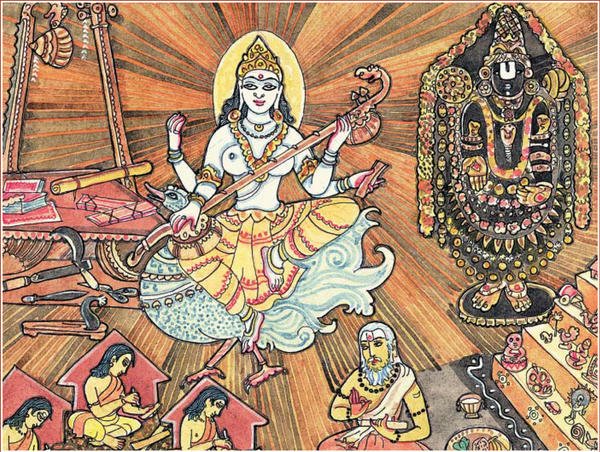
Purattasi (September/October)§
Navaratri (“nine nights”) is the principal festival this month (above left). The Goddess is worshiped in Her many forms, and on the ninth day, Sarasvati (center of the painting) is invoked to bless musical instruments, account books, agricultural instruments and home tools (upper left). On Vijaya Dasami, the day following Navaratri, Goddess Durga is invoked as children are given their first instruction, worship their school books and honor their teacher (bottom left). A decorated display of dolls (lower right) is displayed through the nine days, then dismantled and stored on the tenth day. Vijaya Dasami is also the birthday of Lord Venkateshwara (upper right), presiding Deity of Tirupati Temple in Andra Pradesh, India’s wealthiest temple.
• • • • • • • • • • • • • • • • • • • • • • •§

Aippasi (October/November)§
Skanda Shasti is the first festival of this month (right), commemorating the victory of Lord Murugan over the demon Sura, of the higher, spiritual self over the lower nature. Dipavali is the major event of Aippasi, celebrated everywhere Hindus live and by Buddhists and Jains, too. In one story of its origins, Vamana, the dwarf avatar of Lord Vishnu, requests the amount of land from King Bali that He can cover in three steps. Granted the request, Vamana covers with his first step all of the Earth, with the second all of the sky, and then asks the king where to take the third step. The king offers his own head (lower left), and in commemoration of the king’s humility, the day was established. In another story, Lord Vishnu (center) kills the demon Nagagasvaran with His discus. The various observances (lower right) of Dipavali include an oil bath, gifts of new clothes, fireworks (sufficiently indulged in Chennai to rattle dishes off the kitchen shelves), oil lamps for display and abundant pots of delicious food. The early morning bath is always considered to be in the Ganga itself, so one greeting of the day is, “Did you have the Ganga bath?”
• • • • • • • • • • • • • • • • • • • • • • •§

Karttikai (November/December) §
Krittika Dipa (right) is a joyous one-day festival held on the Krittika nakshatra (when the moon is in Pleiades constellation). Also called Sivalaya Dipa, it is celebrated most famously at Tiruvannamalai (upper left in the painting), on top of Arunachala Hill, home of saint Ramana Maharshi. A bonfire is lit on top that can be seen for miles around. Karthigai Purnima, the full-moon day, honors Lord Murugan. In one traditional story, six sparks from Siva’s third eye became six babies (lower left), later gathered into one six-headed Arumugam (center) by Parvati. Celebrations include lighting hundreds of oil lamps, especially the standing lamp (right) of the home. On this day in Orissa, devotees make banana leaf boats and float them in the river with oil lamps (lower left).
• • • • • • • • • • • • • • • • • • • • • • •§
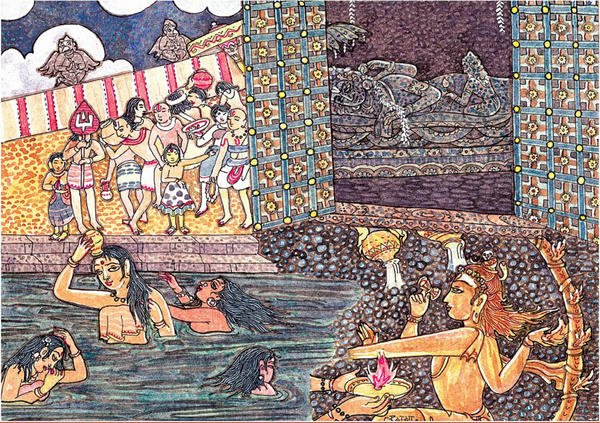
Markali (December/January)§
During Tirupuval (below, in upper left of painting), people bathe (lower left) and gather in the early morning to go on procession singing devotional Vaishnava songs (upper left). Especially popular are those of the 9th century lady saint Andal, venerated as one of South India’s greatest devotional poets. On Vaikunth Ekadasi, the 11th day of the lunar month, the doors of the huge temple of Srirangam are opened to devotees from morning to night for darshan of Rangam, an aspect of Lord Vishnu, sleeping on Adishani, the serpent king (upper right). Another famed festival is Ardra Darshana, when Siva Nataraja is decorated and taken from the temple in procession throughout the community (lower right). Especially the ill and those of old age seek to have a glimpse of Nataraj. A renowned sweet, aurudra kalli, is made with vegetables on this day.
• • • • • • • • • • • • • • • • • • • • • • •§
S. Rajam concluded his descriptions by saying, “All of these festivals are earnestly conducted. People wait for the day with their mind on God. The purpose is to gather in the home and worship for the prosperity of the family and of all mankind.”
• • • • • • • • • • • • • • • • • • • • • • •§